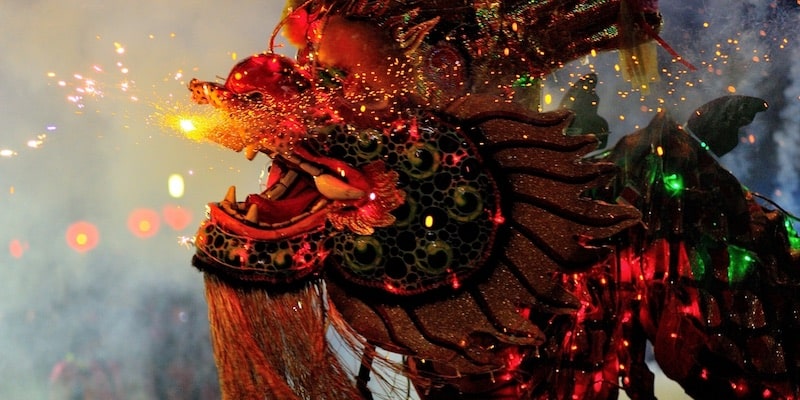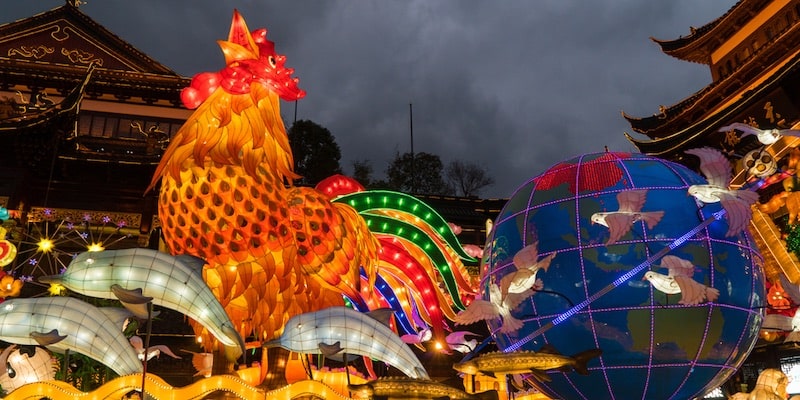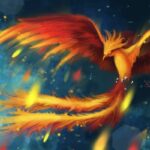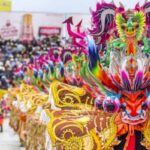We explain what the Chinese New Year is, where and how it is celebrated. In addition, we tell you what the Chinese zodiac is and what its animals are.

What is Chinese New Year?
Chinese New Year (simplified Chinese 农历新年, pinyin nónglì xīnnián) It is the celebration of the end of the astronomical cycle of the traditional Chinese calendar and is the most important festival of the year in China and other regions of Asia. It is also known as the Spring Festival, since it occurs between January and February, when spring begins in the northern hemisphere of the planet; or also like the Lunar New Year, as it is celebrated with 15 days of festivities, from the new moon to the first following full moon.
This celebration has enormous importance in Asia and in the regions with the greatest Chinese immigration, in part because of the majesty of its festivities, which usually involve colorful clothing, fireworks, parades, music and traditional food. But also It represents the largest annual movement of people on the planet, due to the fact that many emigrants and expatriates from the region return to China to spend the holidays with his family.
Chinese New Year It is determined according to the lunisolar calendar that is traditionally used in China and other nations that have been influenced by their culture (Han culture), such as Korea, Japan, Vietnam, Singapore, Mauritius and the Philippines. The annual count of this calendar began in approximately 2697 BC. C., so it is the oldest on the planet. The year 2023, for example, is roughly equivalent to the year 4721. The new year is celebrated on the nearest new moon day that is equidistant between the winter solstice and the spring equinox in the northern hemisphere.
See also: Calendar year
Origins of the Chinese New Year
The origins of the Chinese New Year are uncertain and are linked to different legends. In some, a monster called Nian (“year” in Mandarin Pinyin Chinese) attacked ancient Chinese villages at the beginning of each lunar astronomical cycle but the creature was afraid of loud noises, bright lights, and the color red, so music, fireworks and decorations were used as a way to prevent their attacks.
For its part, the origin of the Chinese lunar calendar dates back to ancient Chinese ages. Some historians attribute it to the Xia dynasty (20th century BC), and the first mythical Chinese emperor Huangdi (27th century BC). The first evidence of the use of the Chinese calendar dates back to the Shang dynasty (1400 BC).
As with other lunar-calendar peoples, farmers of old had trouble fixing their seasons in a way useful for determining harvests, so the calendar it was reformulated around 480 AD. C. to cover 12 seasons (lunar months) with a year of an additional month (13) every three years (embolism year).
Where is Chinese New Year celebrated?

Chinese New Year Celebration has its leading place in mainland China (that is, the People's Republic of China), but is also carried out in its surrounding territories: Taiwan, Hong Kong, Macau and Singapore, and at the same time in the many and very different Chinese migrant communities in the West and throughout the world.
For its part, Other Asian nations commemorate Chinese New Year under other names like the Tết Nguyên Đán (“First Morning of the First Day Festival”) of Vietnam, the Tsagaan sar (“White Moon Festival”) of Mongolia, or the Seollal of Korean culture.
How is Chinese New Year celebrated?

In China, the New Year celebration involves fifteen days of great and multitudinous festivities in which traditional foods such as fish, rice soups, moon-shaped rice cakes and dumplings are cooked (dumplings either jiaozi) in which a coin is often inserted as a sign of good luck.
The streets are decorated with lights and colorful flowers (in which red predominates), especially during the Lantern Festival. This celebration marks the end of the new year and during which lamps are lit in the temples and carried in night parades.
Besides, In the celebratory decorations, the image of the dragon predominates, traditionally considered an icon of good luck so several cardboard and paper mache dragons are displayed in the streets in the middle of dances. These dances are known as the dragon dance (Wulong) or also the lion dance (Wu Shi).
Within the families, which usually meet for the celebration, different rites and traditions are carried out, such as:
- The red envelope traditionhongbao“) which is given to children and younger relatives, with a modest sum of money inside.
- The recitation of antithetical couplets also called “spring couplets,” are written in traditional Chinese calligraphy, using characters associated with good luck, prosperity and happiness.
- The painting of the doors of the houses whether of guardians, that is, images in defensive postures that play a protective role of the family, or of fish or of the pictogram with which this word is written, since its pronunciation is homophonous with that of the word “abundance”.
The Chinese zodiac

Just like the Western zodiac, the Chinese calendar is accompanied by its own astrological signs, which are also twelve, each identified with an animal, and five natural elements, with which they are combined. But unlike the Western solar calendar, in the Chinese calendar Every 60 years a complete cycle is completed and each cycle is made up of five simple cycles of 12 years each which are identified with a respective animal and element, which are:
Chinese zodiac animals:
- The rat or mouse. Associated with intelligence, cunning, wealth, charisma and order, and also with aggression, war, pestilence, the occult and atrocities. The most recent years of the rat are: 1984 (wood rat), 1996 (fire rat), 2008 (earth rat) and 2020 (metal rat).
- The buffalo or ox. Associated with work and prosperity achieved through sustained effort, persistence, tranquility, meekness, patience, fidelity and introversion, but also with rage, brute force and animal fury, jealousy and possession . The most recent years of the ox are: 1985 (wooden ox), 1997 (fire ox), 2009 (earth ox) and 2021 (metal ox).
- The tiger. Associated with power, with action, speed and impulsivity, nobility and passion, but also with unpredictability, egocentrism, fearlessness, competition, stubbornness and vanity. The most recent tiger years are: 1986 (fire tiger), 1998 (earth tiger), 2010 (metal tiger) and 2022 (water tiger).
- The rabbit or the hare. Associated with longevity, grace and good manners, kindness, sensitivity and practical wisdom, but also with comfort, cowardice, laziness, disappointment and distrust. The most recent years of the rabbit or hare are: 1987 (fire rabbit), 1999 (earth rabbit), 2011 (metal rabbit) and 2023 (water rabbit).
- the dragon. Associated with strength, health, good fortune, abundance, harmony, protection (and therefore martial arts), but also with narcissism, frivolity, pride, intransigence and selfishness. The most recent dragon years are: 1988 (earth dragon), 2000 (metal dragon), 2012 (water dragon), and 2024 (wood dragon).
- The snake. Associated with creativity, talent, commitment, lucidity, humor and intuition, as well as with the mysterious, ambition, envy, tricks and Machiavellianism. The most recent snake years are: 1989 (earth snake), 2001 (metal snake), 2013 (water snake), and 2025 (wood snake).
- The horse. Associated with triumph, victory, tenderness, flexibility, adaptation, individual freedom and activity, as well as recklessness, fiery, inconstancy and selflessness. The most recent years of the horse are: 1990 (metal horse), 2002 (water horse), 2014 (wooden horse) and 2026 (fire horse).
- The goat or sheep. Associated with honesty, sincerity, generosity, melancholy and shyness, as well as with pessimism, waste, emotional lack of control and lack of organization. The most recent years of the goat are: 1991 (metal goat), 2003 (water goat), 2015 (wood goat) and 2027 (fire goat).
- The monkey. Associated with sympathy, partying, entertainment, optimism and wit, seduction, but also with suspicion, frivolity, pedantry, ease and infidelity. The most recent monkey years are: 1980 (metal monkey), 1992 (water monkey), 2004 (wood monkey), 2016 (fire monkey), and 2028 (earth monkey).
- The rooster. Associated with eccentricity, intelligence, punctuality, heroism, dignity, elegance, openness and beginnings (or new beginnings), as well as with authoritarianism, vanity, insensitivity and competitiveness. The most recent years of the rooster are: 1981 (metal rooster), 1993 (water rooster), 2005 (wooden rooster), 2017 (fire rooster) and 2029 (earth rooster).
- the dog. Associated with tenderness, fidelity, happiness, self-defense, justice, insight, friendship, adventure and courage, but also with perfectionism, demand, scathing criticism, apprehension and foolishness . The most recent dog years are: 1982 (water dog), 1994 (wood dog), 2006 (fire dog), 2018 (earth dog), and 2030 (metal dog).
- The pig or wild boar. Associated with fertility, vitality, drive, honesty and consideration, directness and perseverance, as well as insecurity, tactlessness and lack of mettle. The most recent pig years are: 1984 (water pig), 1996 (wood pig), 2008 (fire pig) and 2019 (earth pig).
Chinese zodiac elements:
- The water. Associated with the north, winter, cold climate, black color and wavy shapes.
- The wood. Associated with the east, spring, windy weather, the color green and rectangular shapes.
- The fire. Associated with the south, summer, warm climate, red color and angular shapes.
- the land. Associated with the center, the change of seasons, the humid climate, the color yellow and square shapes.
- The metal. Associated with the west, autumn, dry climate, white color and round shapes.
So, The characteristics of each animal and each element are combined with the directions of the yin-yang so some animals are yin (feminine) and others are Yang (male). As in its Greco-Roman version, the Chinese horoscope traditionally fulfills oracular functions, that is, predicting the characteristics of each period for each animal and element.
Continue with: Ancient China
References
- “Chinese Astrology” on Wikipedia.
- “Chinese New Year:What is it and how is it celebrated?” on BBC News.
- “Lunar New Year 2023” on History.com.
- “Chinese New Year” in The Encyclopaedia Britannica.





